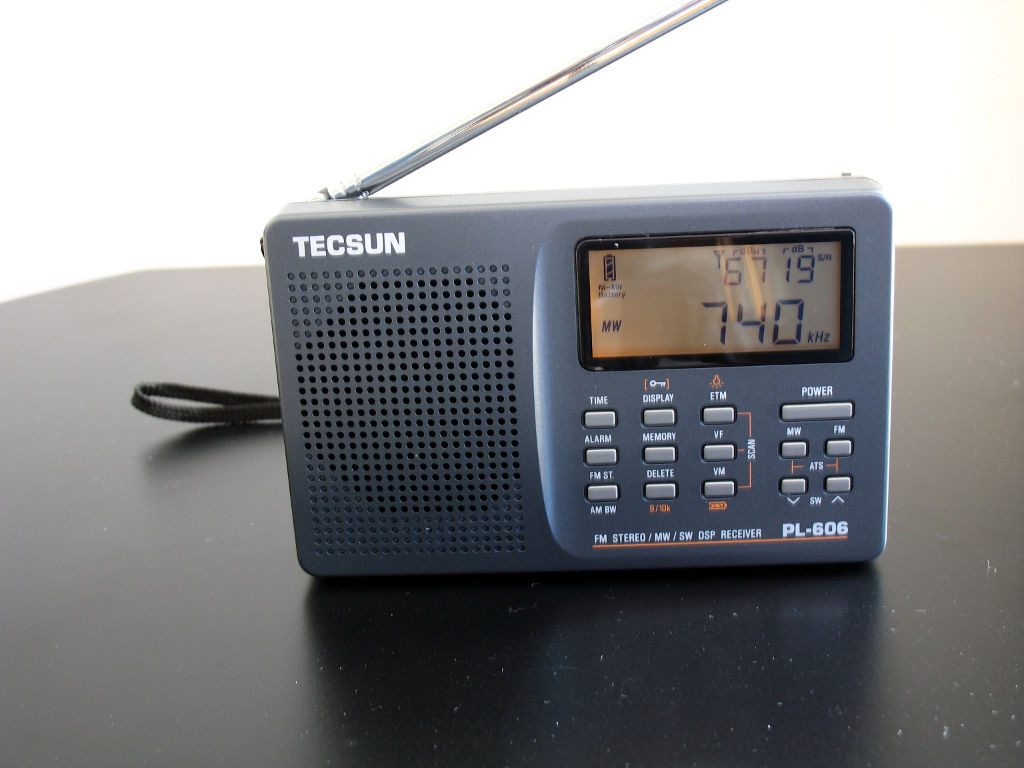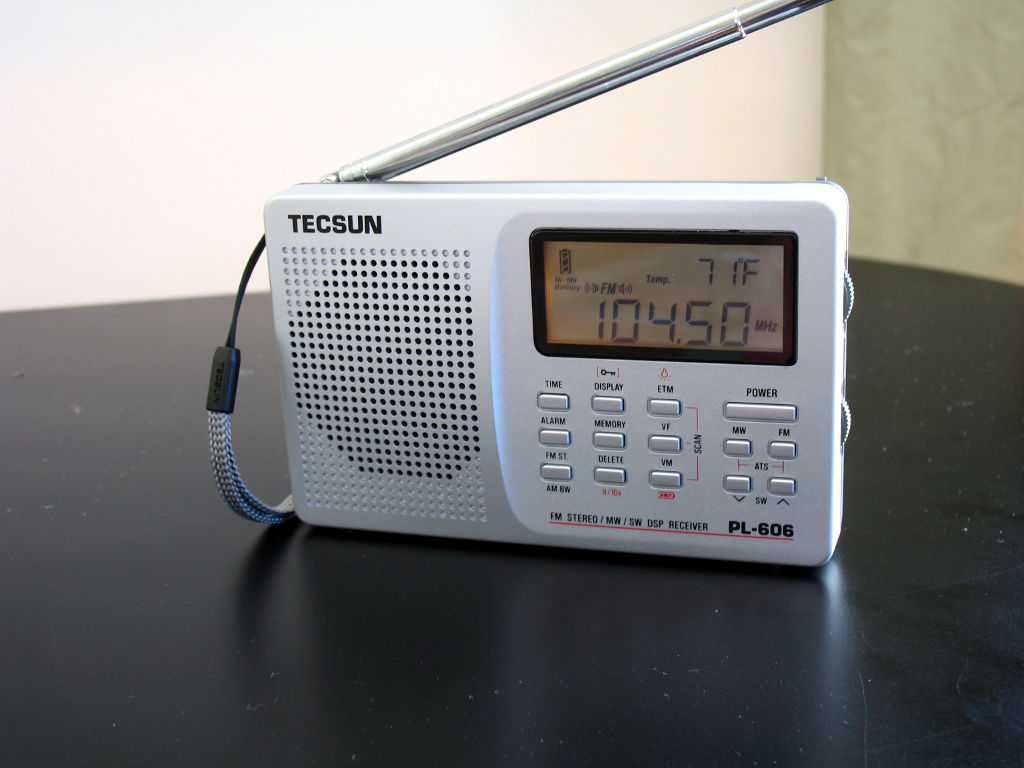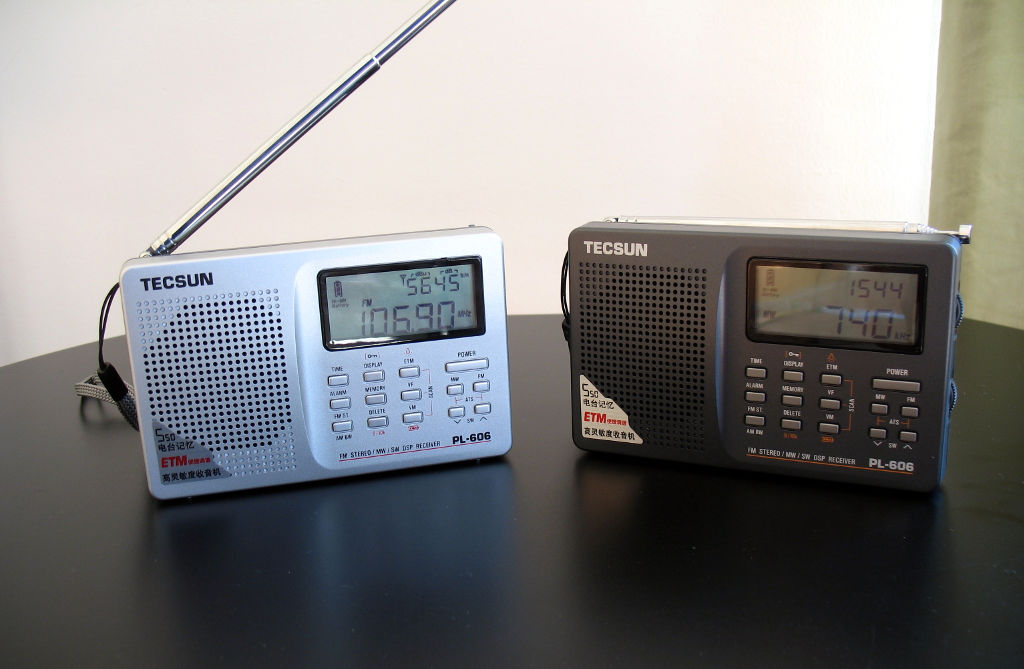
In February, I received two Tecsun PL-606 radios from the Chinese manufacturer Tecsun. As with other Tecsun high-performance radios, the "heart" of the radio is the Silicon Labs SI4734 digital signal processing chip. Interesting enough, even though I've had to order most of my Tecsun radios from Hong Kong via eBay, the SI4734 chip is made in the United States. That's a long round trip! Subsequent to the time that I ordered my PL-606s, the radio has been made available through Amazon by Kaito Electronics. I bought two of them from a Hong Kong reseller for $40 each, including shipping. I bought one in a silver color and the other in gray.
The PL-606 came out about six months before my February order. It's smaller than the Tecsun PL-380 and the Grundig G8, but reportedly has slightly better performance on AM and FM, and far better performance on longwave -- not used in the Western Hemisphere -- than the earlier, bigger radios. I was looking for a better FM radio for my office, which is where FM signals go to die, it seems. I had been using a Degen DE1123 radio for the past few weeks. It also uses the SI4734 chip, but it doesn't seem to do as well in the office environment as I had hoped. For one thing, its antenna is way too short.
The PL-606 still didn't get that entirely right -- the rod antenna only reaches 21 inches in length. It should be around 30. It does come with an extender, but it seems kind of wobbly. I think it might also run an increased risk of breaking the antenna. There's another option, though. Unlike the G8 and the PL-380, it has an antenna jack.
As with the PL-380, the PL-606 has "Easy Tuning Mode," one of two separate memory systems. The other system is the usual method where you manually enter presets. An auto-scanning function is also available for this purpose, though I prefer the manual method. Using Easy Tuning Mode doesn't disturb the memory settings you already have. For example, I could take one of these radios to Paso Robles, with its San Francisco presets, and then set up auto-scanning to pick up the stations there, without erasing my San Francisco presets.
Unlike the PL-380, the PL-606 lacks the ability to directly enter the desired frequency to tune in. The scanning functions are thus essential on this radio. While there is a tuning thumbwheel, it tunes in very small steps -- 1 kHz on AM, 10 kHz on FM. It can take bigger steps, 10 kHz on AM and 100 kHz on FM, but only after you've been spinning that thumbwheel for a while, about 8 seconds. That's tedious. It should have been easy enough to offer a step function switch, similar to that on the G8, and make the bigger step the default.
The other thing I don't like about this radio is that it left out one of the AM audio bandwidths that are available from the SI4734. The PL-380 makes available an audio bandwidth of 6 kHz, for the best fidelity but reduced selectivity, then 4, 3, 2, and 1 kHz. Only hobbyists really would want to use the 2 and 1 kHz settings. Everything sounds muffled at those settings.
A 4 kHz bandwidth has been used in many, many radios as a reasonable compromise between sound quality and reception ability. The PL-380 lets you choose.
The good news with the PL-606 is that the 6 kHz bandwidth is still available. But the 4 kHz bandwidth isn't! The next choice is 3 kHz, which is OK for short periods of time but gets tiring to listen to after a while. This is inexplicable: there would have been no additional cost to add the 4 kHz option. It just would have been one more step on the AM-bandwidth button that switches between the various modes.
There has been one irritating problem frequently reported with this radio: the PL-606 has been known to have a "jumpy" tuning knob, where it becomes difficult to tune to the desired station because the tuning control suddenly jumps ahead several channels, sometimes in the wrong direction. I have had this problem with both of my PL-606s on occasion. One correspondent of mine on Twitter has suggested that this is because dust gets into the control. The PL-606's close sibling, the PL-505, has not shown any signs of this problem.
Another thing that has annoyed some reviewers of the PL-606 is its alarm function. The PL-606 has a function to store the station that you want to use as an alarm. Reading the manual, I thought that feature was optional. It's not. If you want to wake up to an actual radio station, you have to store it in memory.
It's not hard to do: tune to the desired station, press MEMORY, and then press ALARM. Even so, I'm not sure whether to call this a feature or an annoyance.
On the one hand, it means you're guaranteed to get a certain station when the alarm triggers. On the other hand, it means that you have to have set the alarm time and the station before turning the alarm on. That's probably OK if you stay in the same general area. For traveling, it might be a more inconvenient. It's not much more inconvenient, but it's different than the way almost every other radio works, where the alarm turns on to the station that was tuned in when the radio last was on. The Tecsun PL-380 works that way. But the PL-606 doesn't.
It's not a big deal to me -- I still think it's a terrific little radio -- but it was an unexpected twist.
So the alarm, manual tuning, and AM bandwidth choice aren't as good as they are on the PL-380. But a lot of other things are nicer. The antenna jack is a big plus. The display is easier to read. The controls seem a little more intuitive. FM performance seems to be as good as the other Tecsun DSP radios. The AM band seems a little more sensitive. The auto-scan even managed to grab KUBA in Yuba City, which on the dial is right next to semi-local station KLIV. The sound quality is about the same; as with the PL-380 and the G8, this is a radio that's best used with headphones.

It's also smaller than the PL-380 or G8. Not by much, but it is a little more compact. It's compact enough to fit perfectly in a portable hard-drive case from Case Logic (model number PHDC-1). That case is a big improvement over the brown pullstring bag that comes with the radio, and gives it far more protection.
The radio runs on 2 "AA" batteries rather than the 3 used by the PL-380 and the G8. It came with rechargeable batteries and will recharge using any USB-standard source of power.
I tried out one of the PL-606s in my downtown San Francisco office. The result was good: FM reception was improved on some stations compared to the Degen DE1123, and AM reception was surprisingly good and noise-free on the lower half of the AM band, even at the widest bandwidth of 6 kHz.
It was still difficult to get a consistent stereo FM signal on the stations that I could receive. My office location is just a difficult place to receive FM. But it was better than before, in some cases, far better.
Some stations are still impossible. For example, I tried to receive KUSF, soon to be KDFC at 90.3, and I could only get a weak signal in mono. KUSF's antenna, in west-central San Francisco, is just not high enough to make it past the skyscrapers in the path between it and my office. So, no classical in the office, though to be fair, I couldn't get a good signal on KDFC's former home at 102.1.
The PL-606, like the PL-380, allows you to shut off FM stereo reception. Sometimes, FM reception in mono only is far less noisy than it is in stereo. So it's nice to have that option. (The Degen DE1123 doesn't give you that option.)
The AM performance is, I think, even better than the PL-380, at least at 1000 kHz and below. Above that line, the radio's self-generated noises start creating interference, though 1310, with a transmitter site near the Oakland side of the Bay Bridge, came through well. Under 1000, the performance was amazing. 560 (KSFO), 610 (KEAR), 740 (KCBS), 810 (KGO), and even 860 (KTRB) were clear and noise-free. Even 650 from Sacramento came in with a good, listenable signal.
At home, I took a few minutes to do a quick head-to-head comparison of my Tecsun-made DSP radios: the Tecsun PL-606 (2), PL-380, plus the Grundig-branded G8.
I tested the radio on two so-so AM signals, KFBK (1530) and KFRC (1550), and on three weak or impaired FM signals (KNDL, 89.9; KUSF, 90.3; KVYN, 99.3) at my location. Based on reports on DXing mailing lists, I had expected these results:
- The PL-606 would be the best performer
- The PL-380 would be the next best
- The G8 would have the lowest level of performance, but still pretty good
- FM reception on all radios should be equivalent
Here's what my brief, informal, unscientific testing came up with:
- The PL-606 and the G8 were identical performers on AM and FM
- The PL-380 was slightly worse on FM and noticeably not as good as the others on AM
The surprise here was the excellent performance of the G8, which has come in for a lot of grief on some of those mailing lists, but which may, in fact, be just as good as the PL-606, albeit with a different set of features. The PL-380 is still a very good radio, and has some very nice features, but is just a tiny bit less sensitive than the others.
I admit that my sample was limited. On the other hand, I tested the AM stations in the early afternoon, and because of strong winds earlier in the day, there was no temperature inversion or fog at all; thus, FM signals were not getting any additional boost from tropospheric ducting.
 <
<
The PL-606's very good FM performance and good AM performance, combined with its compact size, would make a winning combination, if it weren't for the "jumpy" tuning problem that many PL-606's appear to have. The Tecsun PL-505, while having a plainer physical appearance, may be the better choice, since there haven't been any indications that it has a similar problem with tuning.